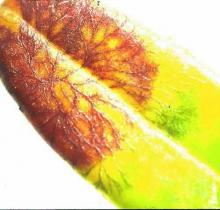Cause A fungus, Protoventuria barriae, common in the cranberry production areas of Oregon and Washington. Whether it affects plant vigor or yield is unknown. It overwinters in the previous season's leaves and in dead leaves in the duff layer.
Symptoms Infected second-year leaves develop distinct reddened circles or rings on the upper surface early in spring. Close examination reveals dark, radiating, subcuticular hyphae. The reddening may disappear by summer, but then rings appear darkened due to the hyphae's presence. Small, dark, fruiting structures, pseudothecia, are produced on the outside of spots after the leaf tissue becomes senescent.
Cultural control None is known. Current fungicide practices against fungal fruit rots may impact (reduce) the severity of this disease.
Reference Carris, L.M., and Poole, A.P. 1993. A new species of Protoventuria on leaves of Vaccinium macrocarpon. Mycologia 85:93-99



